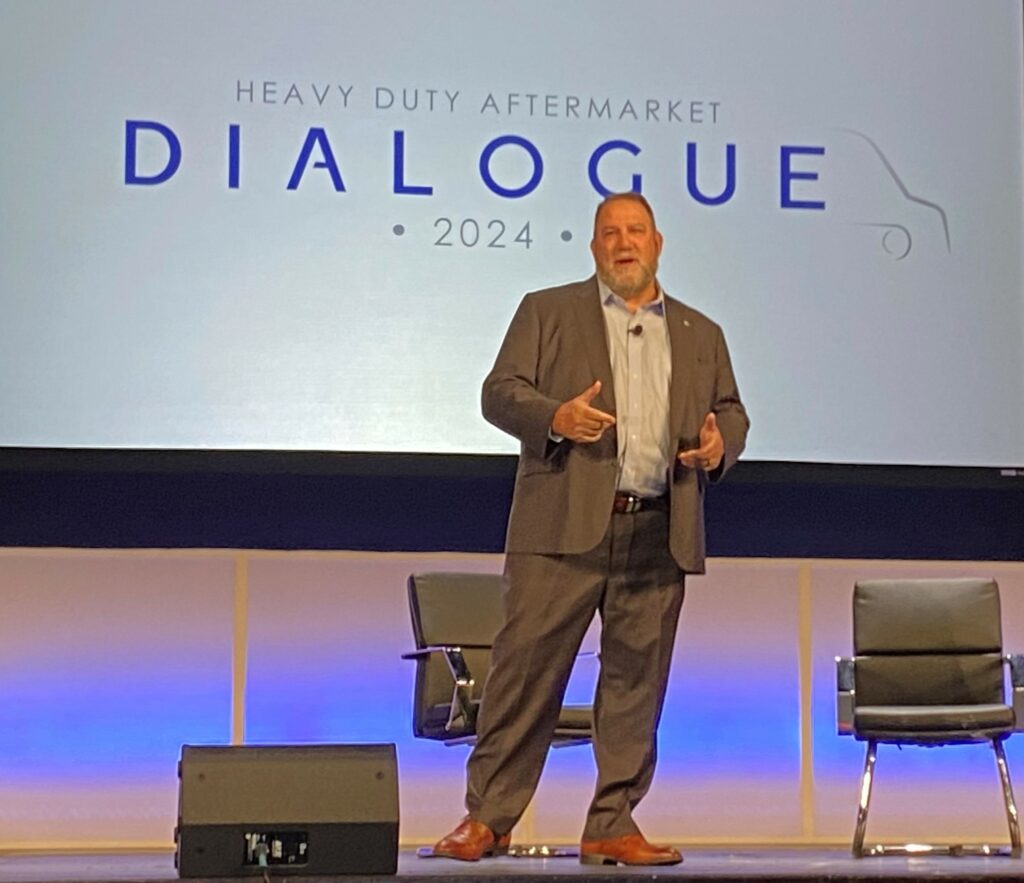Partnerships key to succeeding in strong truck market: Randall
A lot has changed over the past four years, when Volvo Group CEO and president Martin Lundstedt declared at Heavy-Duty Aftermarket Dialogue that “partnership is the new leadership.”
But Jonathan Randall, president of Mack Trucks North America, speaking at the same event this year, said despite all the change seen since, that philosophy holds true – and is maybe even stronger – today.

“We’ve seen that play out over the last four years and continue to play out,” Randall said of such partnerships in the heavy-duty equipment industry. “The reality is, the transparency and collaboration that got us through the last four years is going to be more important through the next decade or beyond as the commercial vehicle industry changes at a pace we haven’t seen.”
Randall said Volvo Group is in the midst of its “single largest product update in group history,” with US$2-billion invested in the North American market alone, including the launch this week of a new Volvo VNL. Meanwhile, the company is investing in its future to supply zero-emission vehicles. This against the backdrop of what’s expected to be a continuing strong market for new iron.
USMCA (U.S.-Mexico-Canada) Class 8 orders closed 2023 at 338,049 units, with Canada and the U.S. accounting for about 297,000 of those. Mack has lowered its forecast for 2024 to 290,000 units, or about 270,000 in the U.S. and Canada. Most of the pull back will occur in the Class 8 longhaul tractor segment, Randall predicted.
Demand for straight trucks and day cabs is expected to remain strong this year. “Our order board for straight trucks is incredibly strong,” he said.
Customer names
How strong? Dealers typically order 30-35% of their trucks as stock units without a customer commitment.
“We haven’t had a truck on a dealer lot in the last three years without a customer name on it,” Randall said. Even now, he said 94% of new orders are already being allocated to a customer at the time of order.
The medium-duty segment totaled 105,000 units in the U.S. and Canada last year, which is expected to grow to 115,000 units this year.
“I would tell you right now, we already see upward pressure on that forecast for medium-duty,” said Randall, which commands about 5% of that space with its new Mack MD medium-duty offering.
In terms of dealer orders, normally about 60% of medium-duty orders would be placed on behalf of a customer, and that too has climbed to 85%.
Randall said supply chain challenges have improved, but not gone away altogether. The truck maker is working with customers to ensure it can meet their equipment demands over the next three years before new emissions standards take hold in 2027.
“History shows that when there’s an emissions standard that comes into play, there is going to be a rush to buy,” he said of a potential pre-buy leading up to 2027. “What we don’t want is this massive 2026 where we’re again not able to meet the demand.”
One of the good things that came out of the pandemic, Randall said, is that fleets are more strategic in placing orders.
Strategic orders
“Customers have realized over the last three years that they need to plan much more in advance to make sure they’re getting the build slots and trucks they need for their future business,” said Randall. “The planning horizon with customers has expanded, which is good for us, because our customers are working with us on one-, two-, and three-year buying cycles.”
He is hopeful customers will work closely with their suppliers to place orders strategically in advance of 2027 to ensure they have the trucks they need to run their businesses rather than scrambling to catch up in 2026 when new trucks may be difficult to procure in the event of a pre-buy.
When it comes to electric vehicles, Randall said the industry is now beyond the early adoption stage and in the evolution phase of adoption, which precedes mass adoption. He said electric trucks will take off when they can be placed into a fleet as a one-for-one replacement for a diesel.
“As technology improves, and battery density improves, we should get there,” he said, noting Mack as orders for about 120 MD electrics, which just went into production late last year.
Customer demands are evolving, Randall noted, to where the truck itself is just one piece of the ecosystem an OE is expected to provide. Randall said the truck is the asset that must be surrounded by other tools that help fleets get the most out of that equipment. Randall likened the truck itself to a referee in a sports match, that when they do their job well, is barely noticed.
Have your say
This is a moderated forum. Comments will no longer be published unless they are accompanied by a first and last name and a verifiable email address. (Today's Trucking will not publish or share the email address.) Profane language and content deemed to be libelous, racist, or threatening in nature will not be published under any circumstances.